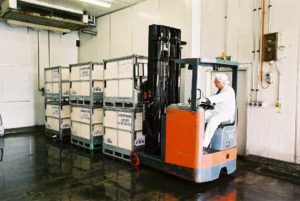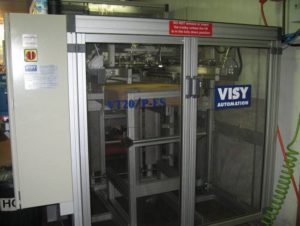Hazards related to plant, equipment and tools
What is the definition of plant?
The Code of Practice, Managing Risks of Plant in the Workplace’ (September 2013) defines plant broadly as:
‘Plant includes any machinery, equipment, appliance, container, implement and tool, and includes any component or anything fitted or connected to any of those things. Plant includes items as diverse as lifts, cranes, computers, machinery, conveyors, forklifts, vehicles, power tools and amusement devices.
Plant that relies exclusively on manual power for its operation and is designed to be primarily supported by hand, for example a screw driver, is not covered by the WHS Regulations. The general duty of care under the WHS Act applies to this type of plant.
Certain kinds of plant, such as forklifts, cranes and some pressure equipment, require a licence from the WHS regulator to operate and some high-risk plant must also be registered with the WHS regulator.’
What are the hazards associated with plant?
Plant is a major cause of workplace death and injury in Australian workplaces. There are significant risks associated with using plant and severe injuries can result from the unsafe use of plant including:
- limbs amputated by unguarded moving parts of machines
- being crushed by mobile plant
- sustaining fractures from falls while accessing, operating or maintaining plant
- electric shock from plant that is not adequately protected or isolated, and
- burns or scalds due to contact with hot surfaces, or exposure to flames or hot fluids.
Other risks include hearing loss due to noisy plant and musculoskeletal disorders caused by manually handling or operating plant that is poorly designed.
What are the glean requirements related to plant?
The Model Work Health and Safety Regulations (which have been passed into legislation in most states of Australia) state that:
‘Regulation 203: A person with management or control of plant at a workplace must manage risks to health and safety associated with the plant.
Regulation 34-38: In order to manage risk under the WHS Regulations, a duty holder must:
- identify reasonably foreseeable hazards that could give rise to the risk
- eliminate the risk so far as is reasonably practicable
- if it is not reasonably practicable to eliminate the risk, minimise the risk so far as is reasonably practicable by implementing control measures in accordance with the hierarchy of control
- maintain the implemented control measure so that it remains effective, and
- review, and if necessary revise, risk control measures so as to maintain, so far as is reasonably practicable, a work environment that is without risks to health and safety.’
It should be noted that there is a legal requirement for control measures to be the most effective controls from the hierarchy of controls wherever possible. For example, plant such as robots may be installed that eliminate risks to workers. Engineering controls such as conveyor belts replacing manual tasks are also preferred options to administrative controls which only put barriers between the risks and the operators. Administrative controls should only be used in association with other more effective controls.

Forklifts eliminate the risk of manual handling injuries carrying heavy loads
Courtesy of Meat and Livestock Australia
Workers are legally required to follow work instructions. Operators may be legally required to undertake training and certification to operate some plant. The certification may need to be updated regularly.
How are risks associated with plant controlled?
Management takes a planned and systematic approach to identify, assess and control risks associated with plant on site. The risk control process is also re-assessed:
- before and during the introduction of plant
- before and during any alteration to plant or change in the way plant or an associated system of work is used, including a change in the location of the plant, which is likely to involve a risk to health and safety
- when new information regarding health or safety becomes available to the employer.
The risk control process is conducted in consultation with employees and their health and safety representatives and includes:
Hazard identification
Management takes a systematic approach to identify and maintain a register of all plant used on site and systematically identify all the hazards associated with each item of plant.
Hazards associated with plant generally arise from:
- The plant itself, for example hazards associated with a forklift would include hazards relating to its mobility, its electrical, hydraulic and mechanical power sources, moving parts, load-carrying capacity and operator protection.
- How and where the plant is used. The forklift, for example may have hazards arising from the kind of loads it is used to lift, the size of the area in which it is used and the slope or evenness of the ground.
Risk assessment
Risk assessment is undertaken in consultation with the employees who use the plant, equipment or tool, and also with those who clean and/or maintain it. The assessment includes consideration of all the factors that may contribute to the risks including:
- frequency and duration of exposure to the risk and risks identified
- work organisation, including the complexity and repetitive nature of the task and the number of employees using the particular plant
- layout and condition of the workplace, including lighting, work space, noise levels, pedestrian traffic, etc.
- condition and maintenance record of the plant, tool or equipment
- manufacturer’s operating instructions, if any, and the usual circumstances of its use, cleaning and maintenance
- guarding and safety device requirements
- the capability, skill and experience of the person using the plant, tools or equipment.
Risk control
Control measures need to be identified for each of the risk factors that have been identified. The most effective controls eliminate the risk of injury by replacing plant and equipment so that the task is automatic. Automatic hock cutters eliminate the risk of injury associated with cutting hocks. The automated carton forming machine eliminates the risk of injury associated with forming cartons, applying glue, etc.
Workers or operators of plant should be consulted about controls. They also need to be trained in implementation of the controls. Workers should also give feedback to management on the effectiveness of the controls.
Reviewing controls
The WHS Regulations state that:
‘Regulation 37: Control measures must be maintained so that they continue to protect workers and other people from the hazards associated with plant. The control measures must be:
- fit for purpose
- suitable for the nature and duration of the work, and
- installed, set up and used correctly.
Regulation 38: A person conducting a business or undertaking must review and as necessary revise control measures:
- when the control measure is not effective in controlling the risk
- before a change at the workplace that is likely to give rise to a new or different health and safety risk that the control measure may not effectively control
- if a new hazard or risk is identified
- if the results of consultation indicate that a review is necessary, and
- if a health and safety representative requests a review’

Automated carton forming machine eliminates the risk of injury
Courtesy Fletcher International © MINTRAC
